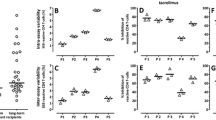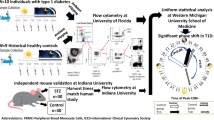Abstract
Purpose
Circadian rhythms play an important role in modulating cellular immune responses. The present study was performed to characterise circadian variations in lymphocyte numbers and antigen-specific T-cell functionality in healthy individuals under physiological conditions.
Methods
Blood leukocyte populations of six healthy volunteers were quantified over 24 h. In addition, antigen-specific T-cell functionality was analysed directly ex vivo from whole blood using flow cytometry based on intracellular cytokine induction after a 6-hour stimulation with adenovirus antigen and Staphylococcus aureus enterotoxin B (SEB), respectively.
Results
T-cell numbers and reactivity were stable during daytime, whereas a significant increase was observed during late evening and early morning hours. The percentage of T cells reacting towards adenovirus antigen and SEB showed a 1.76 ± 0.55-fold (p = 0.0002) and a 1.42 ± 0.33-fold (p = 0.0002) increase, respectively. Dynamics in T-cell reactivity were independent of the mode of antigen stimulation and inversely correlated with plasma levels of endogenous cortisol. Interestingly, peak frequencies of reactive T cells occurred late in the evening and did not directly coincide with peak numbers of bulk T cells that were observed in the early morning hours.
Conclusions
Taken together, our data reveal a circadian regulation of T-cell immune responses in the peripheral blood of humans under physiological conditions. This knowledge may be of practical consequence for the timing of blood sampling for functional T-cell assays as well as for immunosuppressive drug intake after organ transplantation, where T-cell function may be influenced not only by drug-mediated inhibition but also by circadian fluctuations in T-cell reactivity.





Similar content being viewed by others
References
Kelly EA, Houtman JJ, Jarjour NN. Inflammatory changes associated with circadian variation in pulmonary function in subjects with mild asthma. Clin Exp Allergy. 2004;34(2):227–33.
Helena CV, McKee DT, Bertram R, Walker AM, Freeman ME. The rhythmic secretion of mating-induced prolactin secretion is controlled by prolactin acting centrally. Endocrinology. 2009;150(7):3245–51.
Gan EH, Quinton R. Physiological significance of the rhythmic secretion of hypothalamic and pituitary hormones. Prog Brain Res. 2010;181:111–26.
Kreiger DT. Rhythms in CRF, ACTH and crticosteroids. Endocrine rhythms. New York: Raven Press; 1979. p. 123–42.
Gala RR. Prolactin and growth hormone in the regulation of the immune system. Proc Soc Exp Biol Med. 1991;198(1):513–27.
Abo T, Kawate T, Itoh K, Kumagai K. Studies on the bioperiodicity of the immune response. I. Circadian rhythms of human T, B, and K cell traffic in the peripheral blood. J Immunol. 1981;126(4):1360–3.
Haimovich B, Calvano J, Haimovich AD, Calvano SE, Coyle SM, Lowry SF. In vivo endotoxin synchronizes and suppresses clock gene expression in human peripheral blood leukocytes. Crit Care Med. 2010;38(3):751–8.
Suzuki S, Toyabe S, Moroda T, Tada T, Tsukahara A, Iiai T, et al. Circadian rhythm of leucocytes and lymphocytes subsets and its possible correlation with the function of the autonomic nervous system. Clin Exp Immunol. 1997;110(3):500–8.
Lange T, Dimitrov S, Born J. Effects of sleep and circadian rhythm on the human immune system. Ann N Y Acad Sci. 2010;1193:48–59.
Born J, Lange T, Hansen K, Molle M, Fehm HL. Effects of sleep and circadian rhythm on human circulating immune cells. J Immunol. 1997;158(9):4454–64.
Tornatore KM, Reed K, Venuto R. 24-hour immunologic assessment of CD4+ and CD8+ lymphocytes in renal transplant recipients receiving chronic methylprednisolone. Clin Nephrol. 1995;44(5):290–8.
Dimitrov S, Benedict C, Heutling D, Westermann J, Born J, Lange T. Cortisol and epinephrine control opposing circadian rhythms in T cell subsets. Blood. 2009;113(21):5134–43.
Magee MH, Blum RA, Lates CD, Jusko WJ. Pharmacokinetic/pharmacodynamic model for prednisolone inhibition of whole blood lymphocyte proliferation. Br J Clin Pharmacol. 2002;53(5):474–84.
Kawate T, Abo T, Hinuma S, Kumagai K. Studies of the bioperiodicity of the immune response. II. Co-variations of murine T and B cells and a role of corticosteroid. J Immunol. 1981;126(4):1364–7.
Bollinger T, Bollinger A, Skrum L, Dimitrov S, Lange T, Solbach W. Sleep-dependent activity of T cells and regulatory T cells. Clin Exp Immunol. 2009;155(2):231–8.
Sester M, Sester U, Alarcon Salvador S, Heine G, Lipfert S, Girndt M, et al. Age-related decrease in adenovirus-specific T cell responses. J Infect Dis. 2002;185(10):1379–87.
Bollinger T, Bollinger A, Naujoks J, Lange T, Solbach W. The influence of regulatory T cells and diurnal hormone rhythms on T helper cell activity. Immunology. 2010;131(4):488–500.
Fortier EE, Rooney J, Dardente H, Hardy MP, Labrecque N, Cermakian N. Circadian variation of the response of T cells to antigen. J Immunol. 2011;187(12):6291–300.
Kennaway DJ, Owens JA, Voultsios A, Varcoe TJ. Functional central rhythmicity and light entrainment, but not liver and muscle rhythmicity, are Clock independent. Am J Physiol Regul Integr Comp Physiol. 2006;291(4):R1172–80.
Oishi K, Ohkura N, Kadota K, Kasamatsu M, Shibusawa K, Matsuda J, et al. Clock mutation affects circadian regulation of circulating blood cells. J Circadian Rhythms. 2006;4:13.
Depres-Brummer P, Bourin P, Pages N, Metzger G, Levi F. Persistent T lymphocyte rhythms despite suppressed circadian clock outputs in rats. Am J Physiol. 1997;273(6 Pt 2):R1891–9.
Silver AC, Arjona A, Hughes ME, Nitabach MN, Fikrig E. Circadian expression of clock genes in mouse macrophages, dendritic cells, and B cells. Brain Behav Immun. 2012;26(3):407–13.
Sester M, Gärtner BC, Sester U. Monitoring of CMV specific T-cell levels after organ transplantation. J Lab Med. 2008;32(3):121–30.
Mack U, Migliori GB, Sester M, Rieder HL, Ehlers S, Goletti D, et al. LTBI: latent tuberculosis infection or lasting immune responses to M. tuberculosis? A TBNET consensus statement. Eur Respir J. 2009;33(5):956–73.
Lange T, Dimitrov S, Bollinger T, Diekelmann S, Born J. Sleep after vaccination boosts immunological memory. J Immunol. 2011;187(1):283–90.
Bollinger T, Bollinger A, Oster H, Solbach W. Sleep, immunity, and circadian clocks: a mechanistic model. Gerontology. 2010;56(6):574–80.
Knapp MS, Pownall R. Lymphocytes are rhythmic: is this important? Br Med J (Clin Res Ed). 1984;289(6455):1328–30.
Gaddameedhi S, Selby CP, Kaufmann WK, Smart RC, Sancar A. Control of skin cancer by the circadian rhythm. Proc Natl Acad Sci U S A. 2011;108(46):18790–5.
Cutolo M, Masi AT. Circadian rhythms and arthritis. Rheum Dis Clin North Am. 2005;31(1):115–29. ix-x.
Sutherland ER. Nocturnal asthma. J Allergy Clin Immunol. 2005;116(6):1179–86. quiz 87.
Acknowledgements
We thank Candida Guckelmus for expert technical assistance, Dr. M. Erhard (Department of Gastroenterology, Saarland University) for help in performing cortisol analyses, and Dr. M. Enders (Labor Enders & Partners, Stuttgart, Germany) for performing serological analysis.
Conflict of interest
The authors declare that they have no conflict of interest.
Author information
Authors and Affiliations
Corresponding author
Rights and permissions
About this article
Cite this article
Kirsch, S., Thijssen, S., Alarcon Salvador, S. et al. T-cell Numbers and Antigen-specific T-cell Function Follow Different Circadian Rhythms. J Clin Immunol 32, 1381–1389 (2012). https://doi.org/10.1007/s10875-012-9730-z
Received:
Accepted:
Published:
Issue Date:
DOI: https://doi.org/10.1007/s10875-012-9730-z




